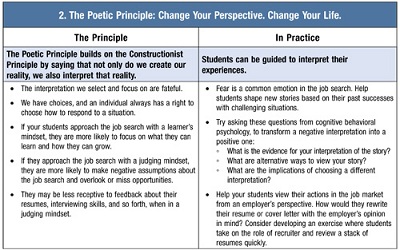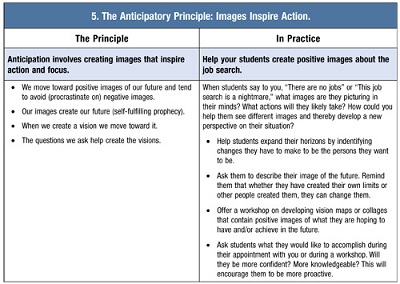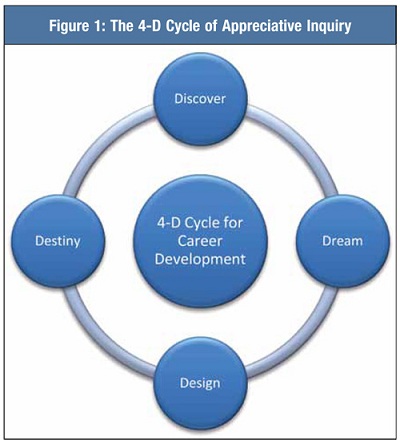NACE Journal, March 2013
"As coaches, we are in the business of possibilities."
Orem, Binkert, and Clancy, Appreciative Coaching
Helping students stay positive in the face of a difficult job market continues to be a challenge for college career services practitioners. The field of positive psychology has provided new theories, research, and resources tosupport career practitioners, but the theoretical nature of much of the research, and its broad application to general life coaching rather than career coaching specifically can make it difficult for career practitioners to apply the knowledge. Career coaches and students are interested in action-oriented techniques and information that can be applied effectively and efficiently in workshops, one-on-one sessions, and through handouts and web pages.
One of the most powerful of the strength approaches is appreciative inquiry (AI). Initially developed by David Cooperrider as a human resources tool for improving institutional environments, AI is closely related to positive psychology and can be applied directly to college students. Appreciative inquiry is a positive solution-focused approach to problem solving and is sometimes labeled appreciative coaching, appreciative advising, and appreciative living. These labels tend to reflect the population served: Appreciative inquiry focuses primarily on organizations, while the other terms apply more to work with individuals. The bottom line, though, is that AI represents a valuable positive approach to the challenges college students are facing.
Following is an overview and introduction to appreciative inquiry as it applies to college student career advising or coaching.
Appreciative inquiry is particularly applicable to college students because it is:
- Improvisational and flexible. AI is a flexible approach that allows you to be creative and develop your own techniques. AI techniques can be applied in a variety of settings from workshops to handouts to one-on-one sessions.
- Action-focused. While there are philosophical underpinnings that enrich one’s understanding, AI at its heart is an action-oriented approach.
- Question-based. Asking strategically designed questions will help students develop a vision for the best possible future.
- Mindset-based. AI teaches students a mindset and strategy for moving forward in any situation, regardless of obstacles or issues.
- Possibility-focused. AI shifts the client’s focus away from negativity and anxiety to what is possible and what he or she wants.
- Solution-focused. By focusing on solutions and what is right about a situation, you can help students break through resistance and avoid getting stuck in problem analysis.
Five Core Principles of Appreciative Inquiry
Five core principles form the foundation of appreciative inquiry and represent the thinking and mindsets behind AI. Following are explanations of each principle and specific ways to apply them with college students.





Applying the 4-D Cycle to Career Coaching
The principles provide a philosophical framework for the coaching sessions and the 4-D cycle of appreciative inquiry offers even more structure to the coaching process. The term 4-D applies to the four phases of the appreciative inquiry process (discover, dream, design, and destiny) which can help your students discover their career and life dreams, develop a plan of action, and move forward. A thorough explanation of the 4-D system with numerous questions and techniques can be found in the book Appreciative Coaching (see the references section for more information).
Think of the 4-D phases as a cycle that students will need to move through (and occasionally back and forth) as needed.
Begin the 4-D cycle by establishing the topic: Why is the student seeing you? If the topic is presented in an unclear or negative way, reframe it as a positive strengths-oriented topic to build on, such as:
- “I don’t know how to look for a job” might change to “I want to identify three steps I can take to start my job search.”
- “I don’t know what to do” could become “I would like to focus on specific career fields that match my skills and interests.”
- “I am stuck in (this location) because that’s where my spouse works” could become “I would like to find an interesting opportunity in (this location).”
Once you have established the purpose of the meeting, you move into the discover phase.
The Discover Phase
Now that you’ve established the purpose of your meeting with the student, you can mine the student’s background and history for strengths and help him or her develop a broader perspective about the future. You can also help silence his or her internal critic.
Keep in mind the topic you’re focused on so that you seek out strengths and skills specifically related to the topic. Throughout this phase you are moving the student’s language from problem-focused to solution-focused. If the student focuses on what he or she doesn’t want, respond with “So we know what you don’t want—what would you like instead?” Help your student focus on the future possibilities,again with a positive frame.
As you listen to the resistance, concerns, fears, and so forth, that show up in their statements and stories, you can help place these negative feelings in a positive frame through identifying the strengths the students have to help them overcome challenges. You can also let them know that they have the power to change their future if they choose to and if they focus on making good choices.

Some questions to ask during this time:
- What are your top five strengths?
- How could you build on your strengths?
- When have you been at your all-time best? What were you doing? What did you like about it?
- What talents and strengths would you like to carry into your future?
- Do you think an employer would appreciate these strengths? How might these strengths make you a better employee?
- How could your pattern of strengths apply to…? (Insert whatever the topic is, such as the job search, an upcoming interview, a networking session, and so forth.)
The discovery phase is also a good time to help the student ponder an expanded horizon:
- I wonder what would happen if ... ?
- What if you tried … ?
- What would you like to achieve?
Once you have helped the student identify his or her strengths, it’s time to move into the dream phase and begin sharpening his or her vision ofthe future.
The Dream Phase
This is a time to be both practical and visionary as you look at “what might be.” Help the student examine his or her hopes and dreams related to the future—the discussion might start with careers but might also move onto other visions (e.g. family or work/life balance) because that can be an integral part of the dream phase.
Keep in mind that the dream phase is about creating a deliberate and concrete vision of the dream. Focus on the dream, not the steps to get there. Don’t get caught up in the “how” of the dream.
You will want to ask questions that inspire students to see their future, such as:
- What does your future look like? What do you see when you picture it?
- Can you see yourself living it?
- What are you doing, thinking, or feeling?
- Describe a typical day when you’re living your dream.
As you help students create and develop their dreams, it’s important to ask:
- Are you gaining energy as you focus on this dream?
- What skills or knowledge do you need to acquire to make your dream a reality?
If their dream is far in the future ask them what they could do now to prepare for it. Notice what fears, “shoulds,” or other forms of resistance come up as the student discusses his or her dream. How can you support the student and help him or her see past the problems?
The Design Phase
The design phase is the time to design an action plan to make the dream a reality. Sometimes it’s described as building the scaffolding.
One simple question can start the process: Now that you have your dream in mind, can you do it tomorrow?
Based on the student’s answer to that question, create a list of actions to take—but with the reminder that this doesn’t have to include every single step in the process. Create as detailed or as open a plan as appropriate. Be careful not to overwhelm the student.The goal is to move forward—not get overwhelmed or stuck.
- What could you do to move one step closer to your dreams?
- What person or resources could assist you?
- What have you already put in place?
This is the perfect time to help students organize their job searches, write resumes and cover letters, prepare for interviews, and so forth.
Help students keep their dreams in mind as they do the hard work of preparing for the job search. A student could be in this stage for some time, particularly if he or she is in a field where jobs aren’t as plentiful.
The Destiny Phase
At this point students are now experiencing some success—maybe an internship, a job offer, or even a job. This period gives you an opportunity to ask questions that can help them determine if they have made the right choices and encourage them to continue developing their skills. Focus on all the good that has been accomplished.
Some questions to help assess their current situation include:
- Where do you see yourself excelling?
- Do you feel more confident?
- What skills have you developed in the process of finding your job?
- How can you continue to broaden and build your skills?
- What job seeking skills have you developed?
- Have you mastered interviewing?
- Is your resume well-written and tailored to your new profession?
- Have you learned to network?
- Are you taking advantage of social media?
At this point, you may no longer have contact with the student—except perhaps as a successful alumnus who can now return to share his or her story with your current students. Or—if something doesn’t work out—the student may return to start the process again. It’s not unusual to work through the stages only to have the student take an internship and learn that the chosen career field is no longer working for him or her. This may be the start of a whole new cycle of 4-D questions, reflections, and actions.
Moving Forward
This article covers the basics of appreciative inquiry and appreciative coaching, but there is much more to learn. If you plan to use AI:
- Read all you can about appreciative inquiry. Many individuals and organizations have posted articles, PowerPoints, and other information online that you can use to develop your knowledge.The reference section at the end of this article provides additional resources.
- Try selecting one principle or technique each week to use with your students. Discover what works and build up your arsenal of techniques.
- Find a colleague to share the AI process with. Check in with each other to discuss techniques, what’s working, what’s challenging, and so forth.
References
Brooks, Katharine. Expanding Horizons:An Appreciative Approach to Career Development. Training manual created for in-house training for California Community College System, 2011.
Gordon, Sandy. “Appreciative Inquiry Coaching,” International Coaching Psychology Review. Vol. 3, No. 1. The British Psychological Society: March 2008, pp. 19-31.
Hammond, Sue. The Thin Book of Appreciative Inquiry. Second Edition. Plano, Texas: Thin Book Publishing Company, 1998.
Howell, Nancy G. “Appreciative Advising from the Academic Advisor’s Viewpoint: a Qualitative Study.” University of Nebraska at Lincoln. Dissertation abstracts international, 2010. http://digitalcommons.unl.edu/dissertations/AAI3398312/.
Kelm Jacqueline. The Joy of Appreciative Living. New York: Tarcher, 2008.
Orem, Sara; Binkert, Jacqueline; and Clancy, Ann. Appreciative Coaching. San Francisco: Jossey-Bass, 2007.
Stavros, Jacqueline M. Torres, Cheri B. Dynamic Relationships. Chagrin Falls, OH: Taos Institute Publications, 2008.
Watkins, Jane and Mohr Bernard J. Appreciative Inquiry: Change at the Speed of Imagination. New York: Jossey-Bass/Pfeiffer, 2001.
Whitney, Diana and Trosten-Bloom, Amanda.The Power of Appreciative Inquiry: A Practical Guide to Positive Change. San Francisco: Berrett-Koehler Publishers,Inc., 2003.
Copyright 2013 by the National Association of Colleges and Employers. All rights reserved.







